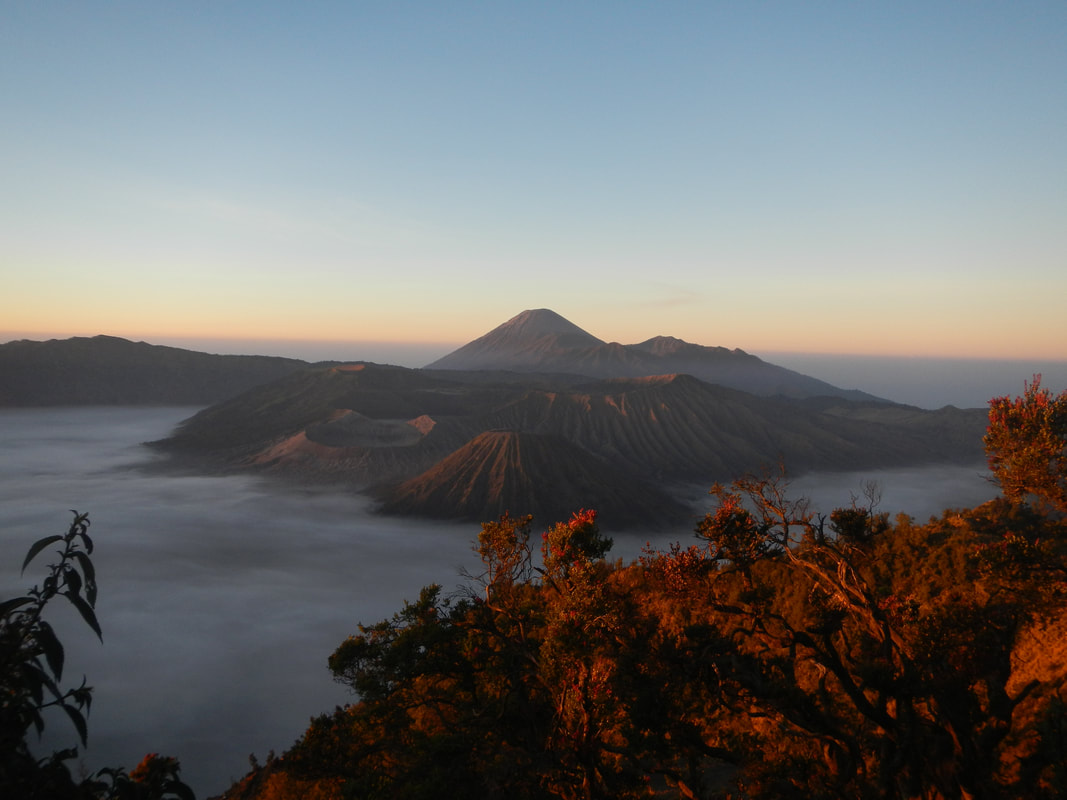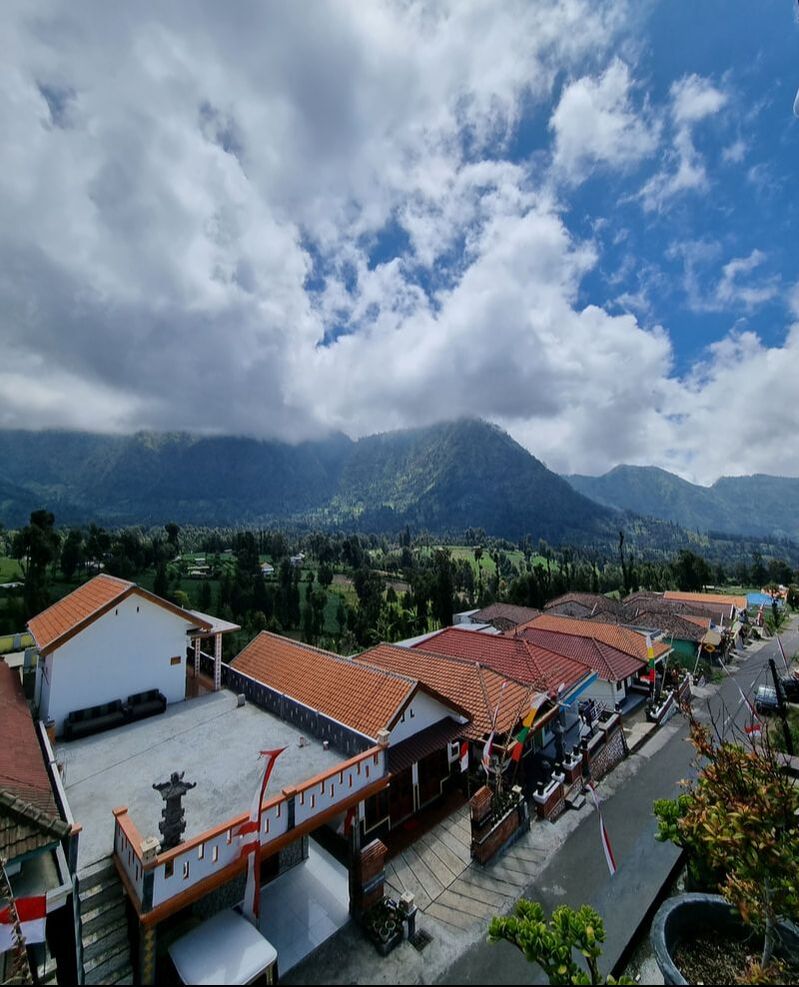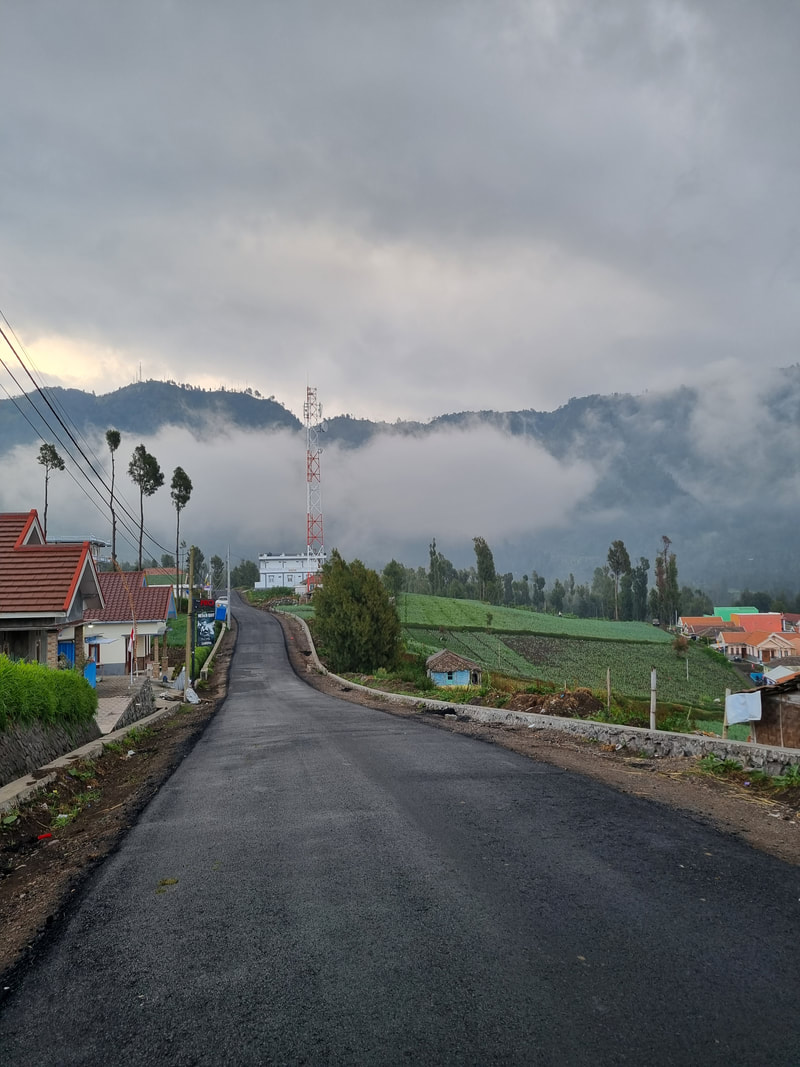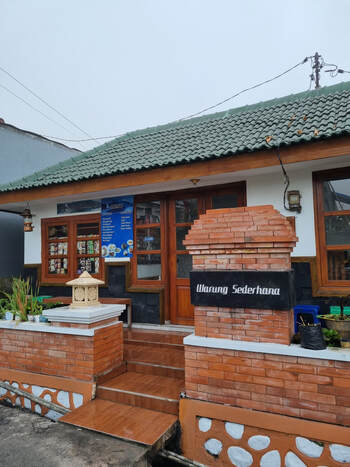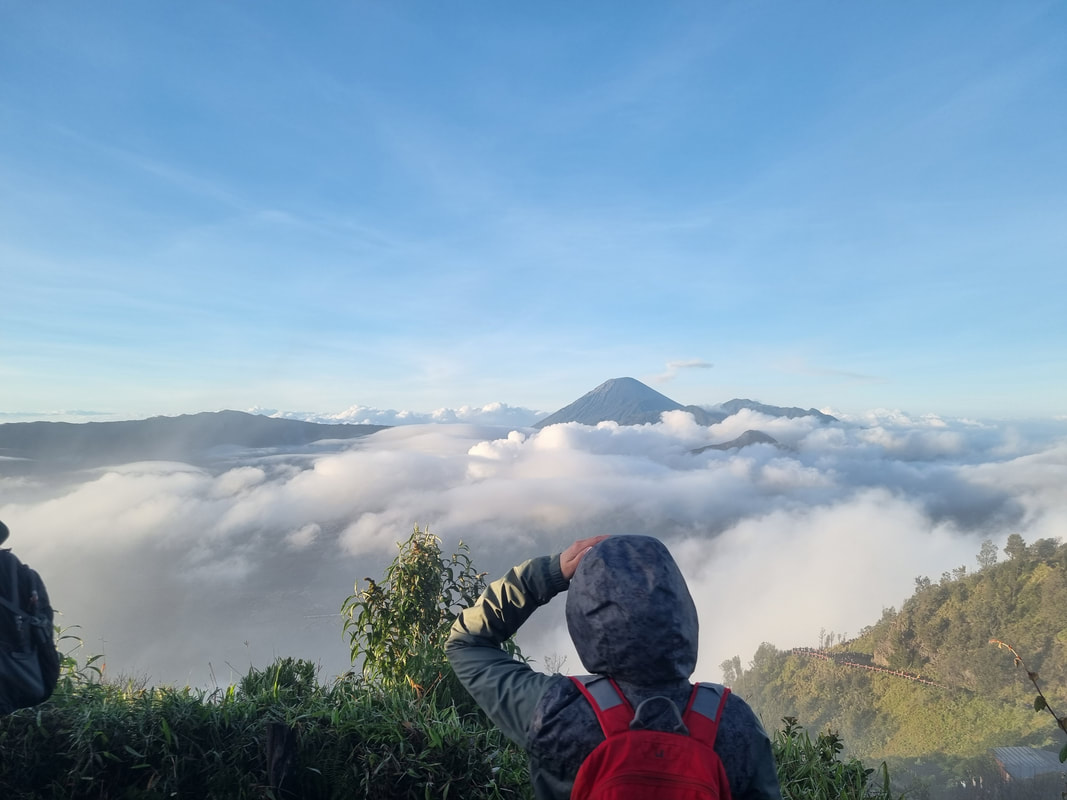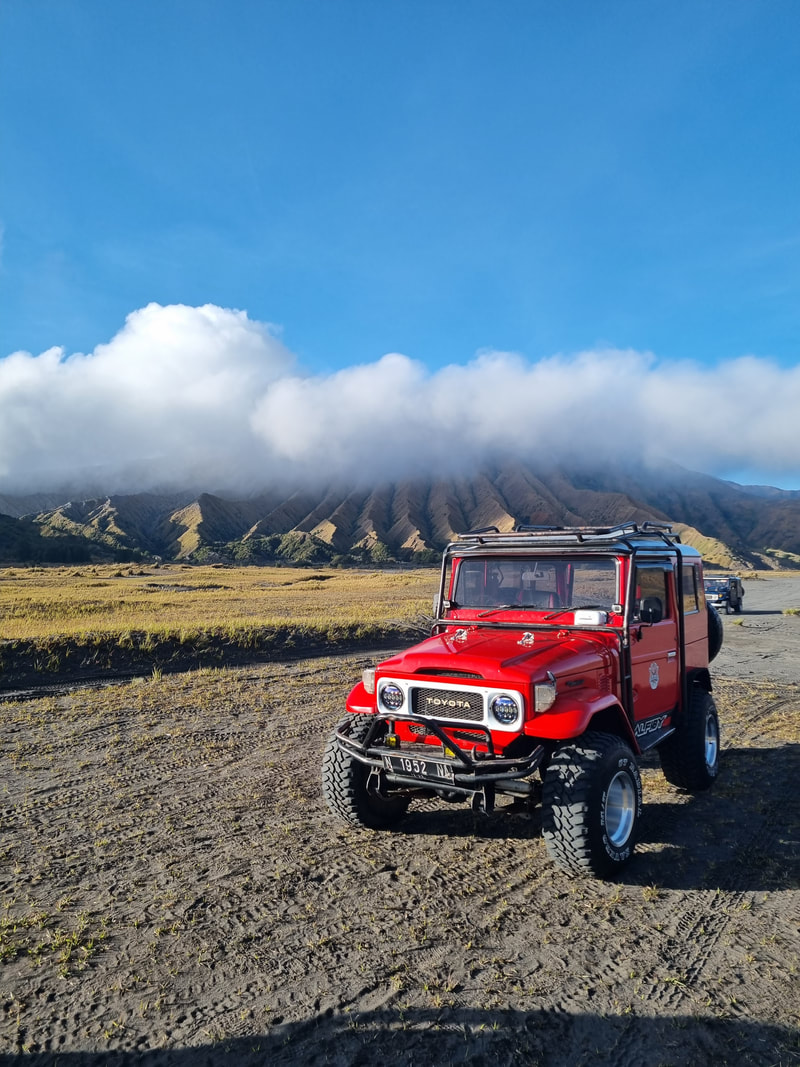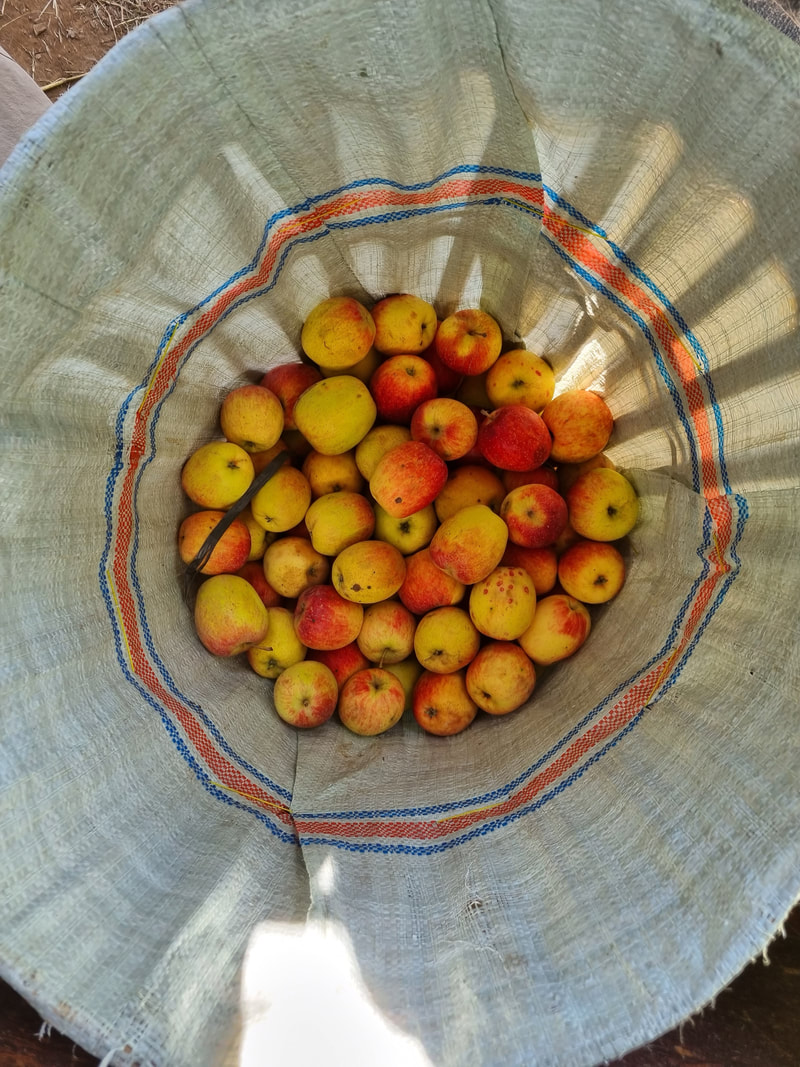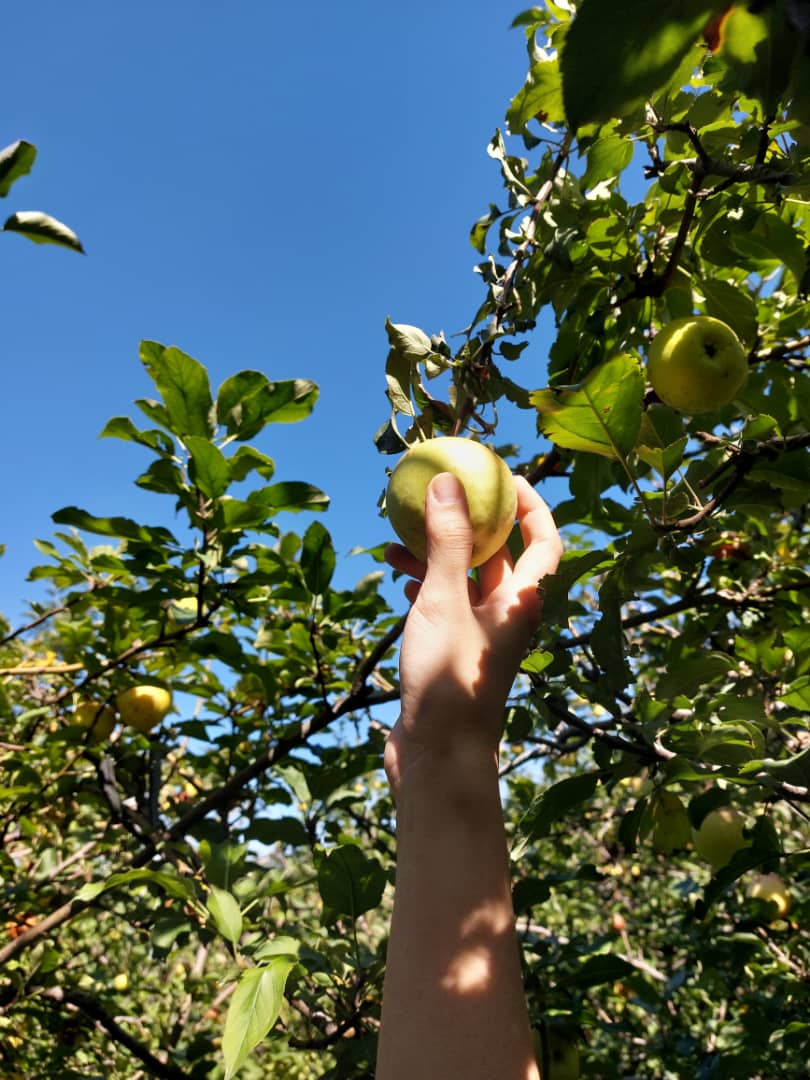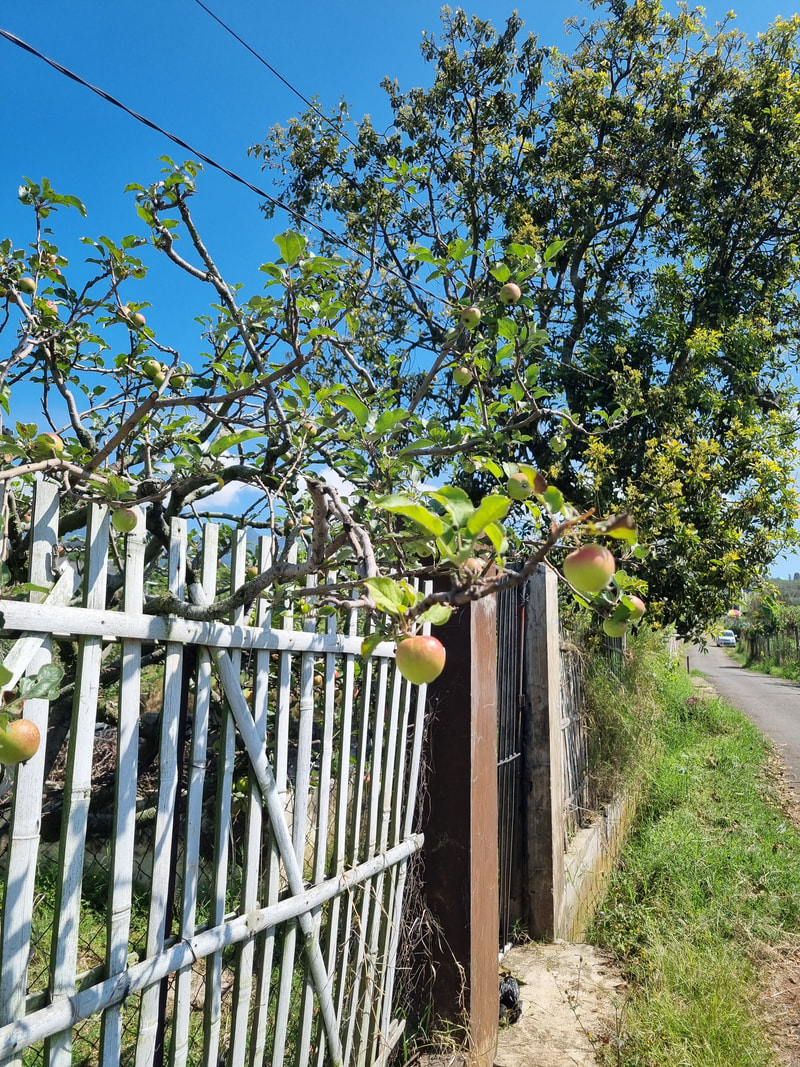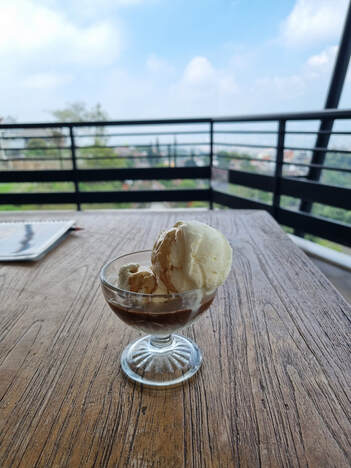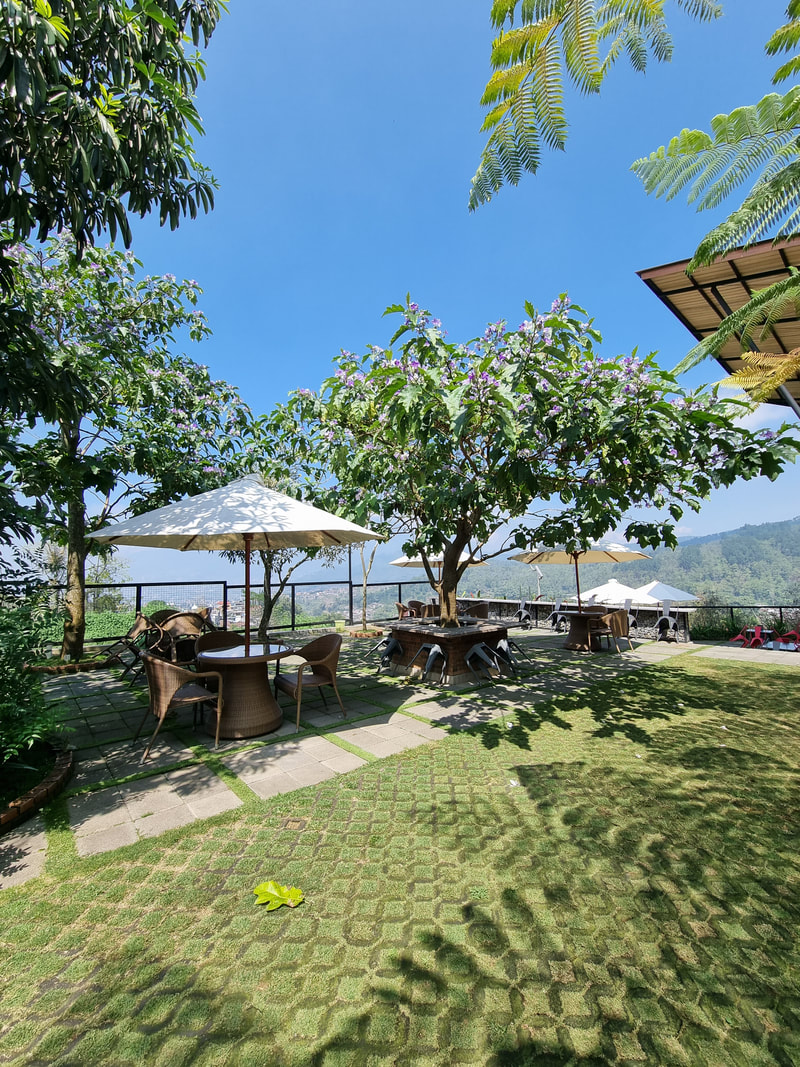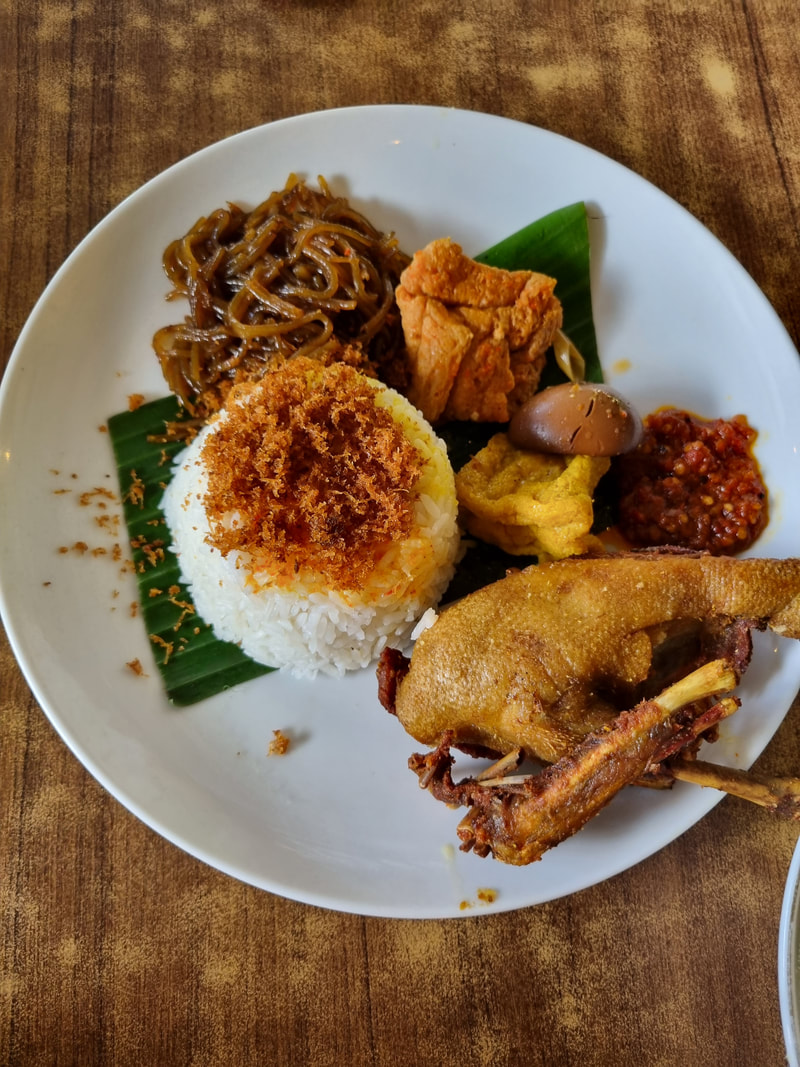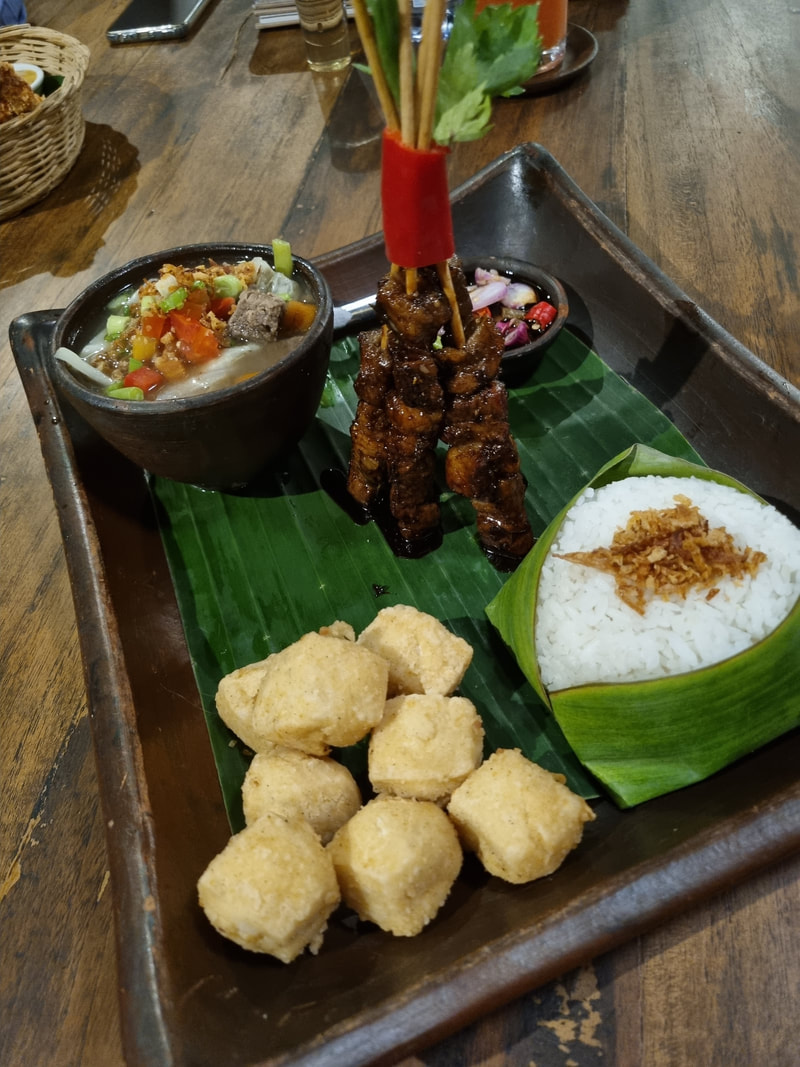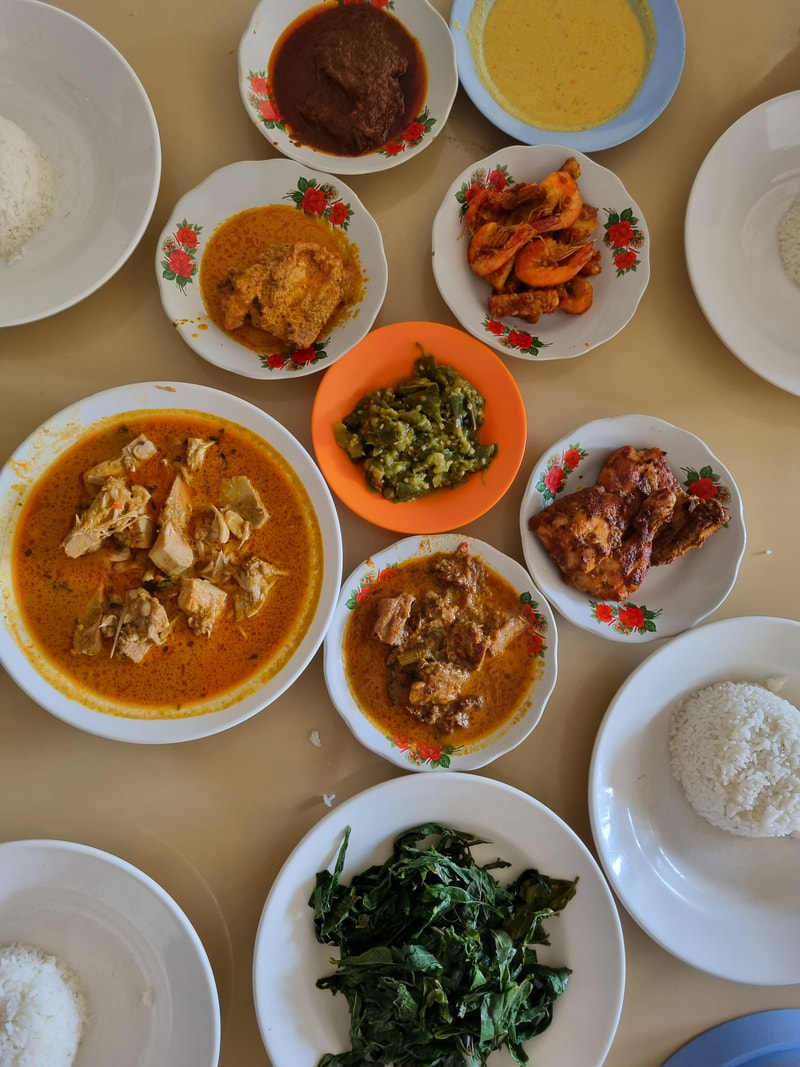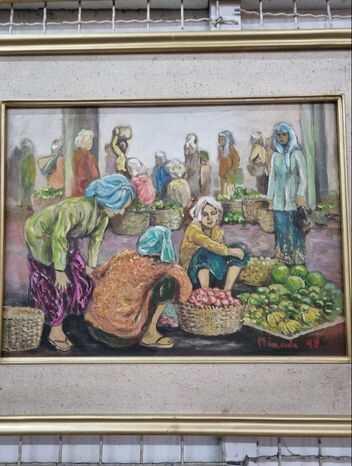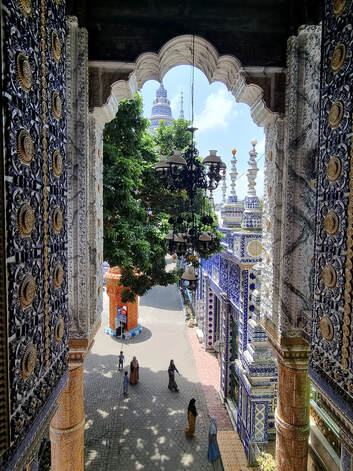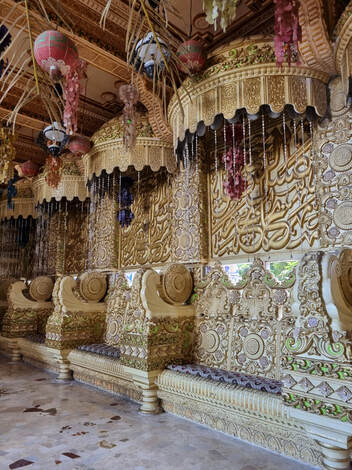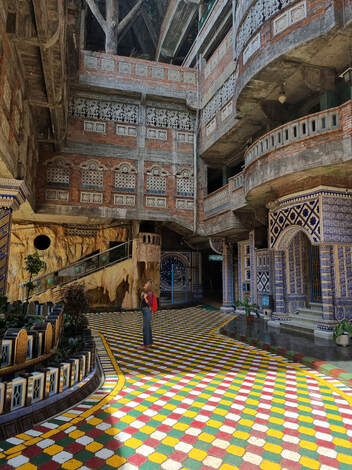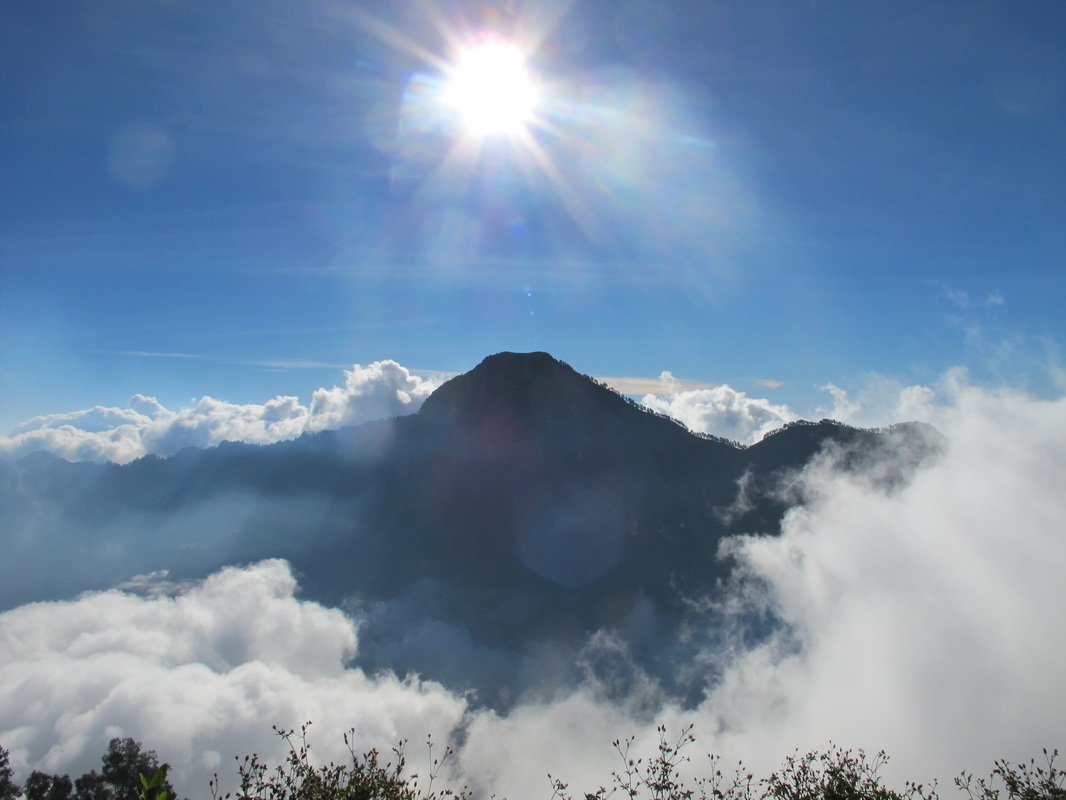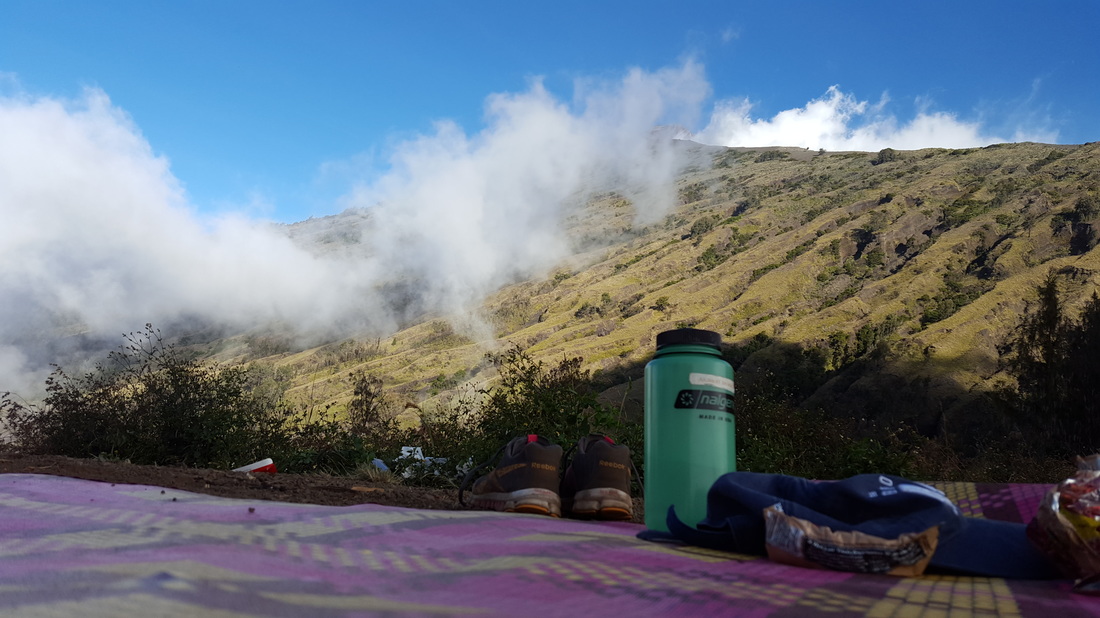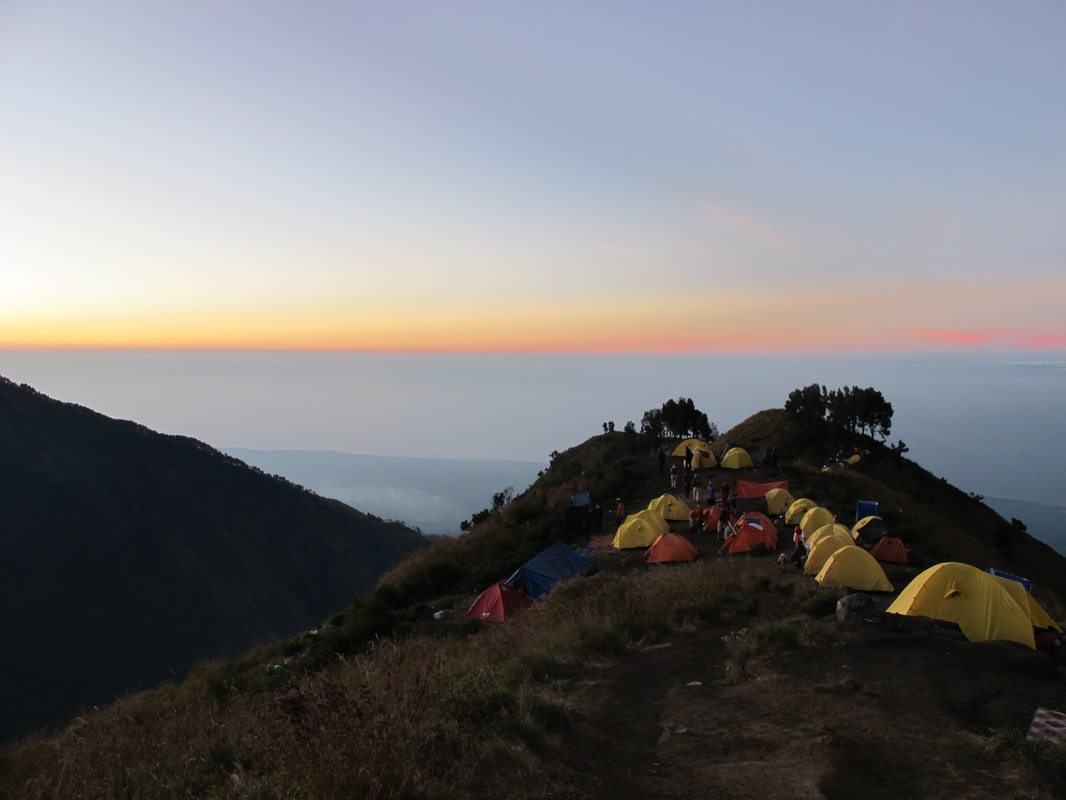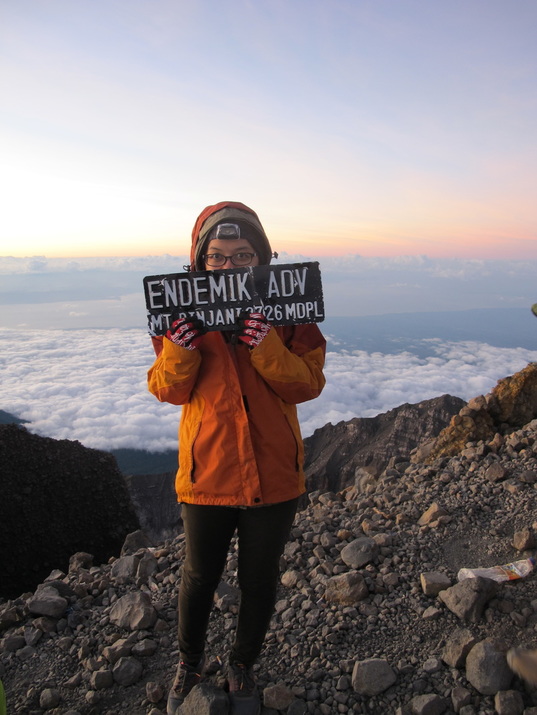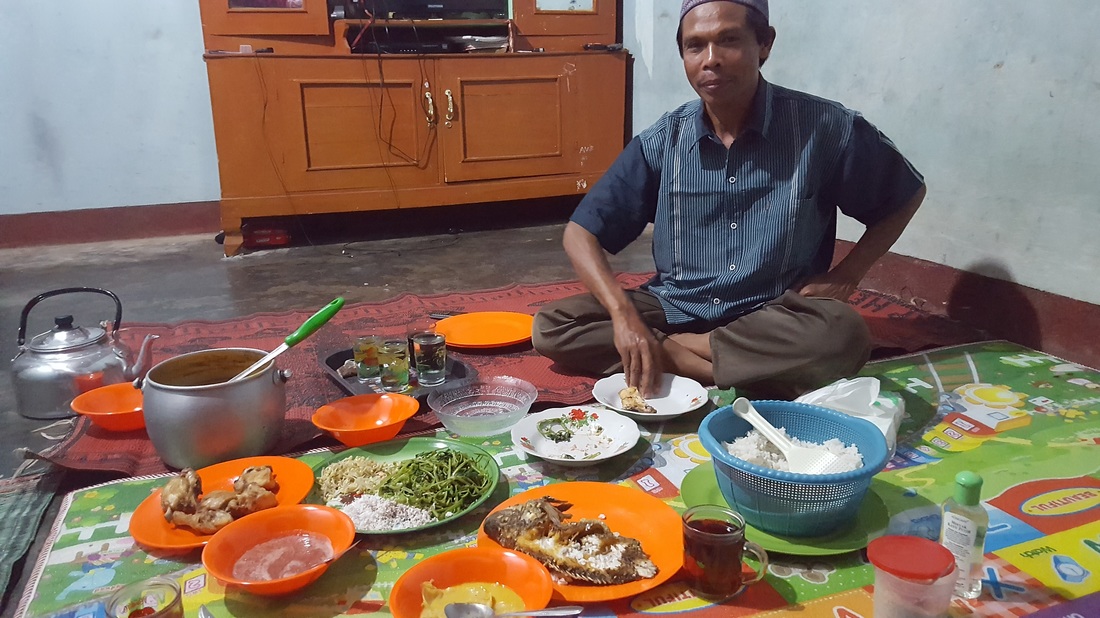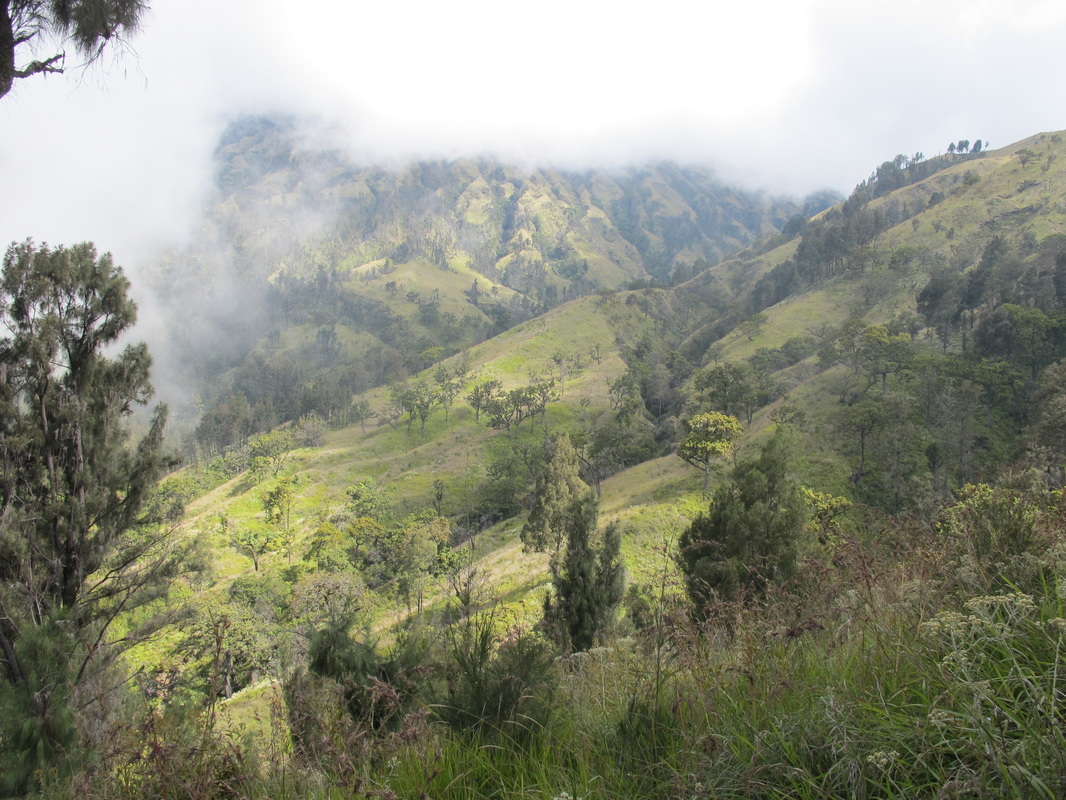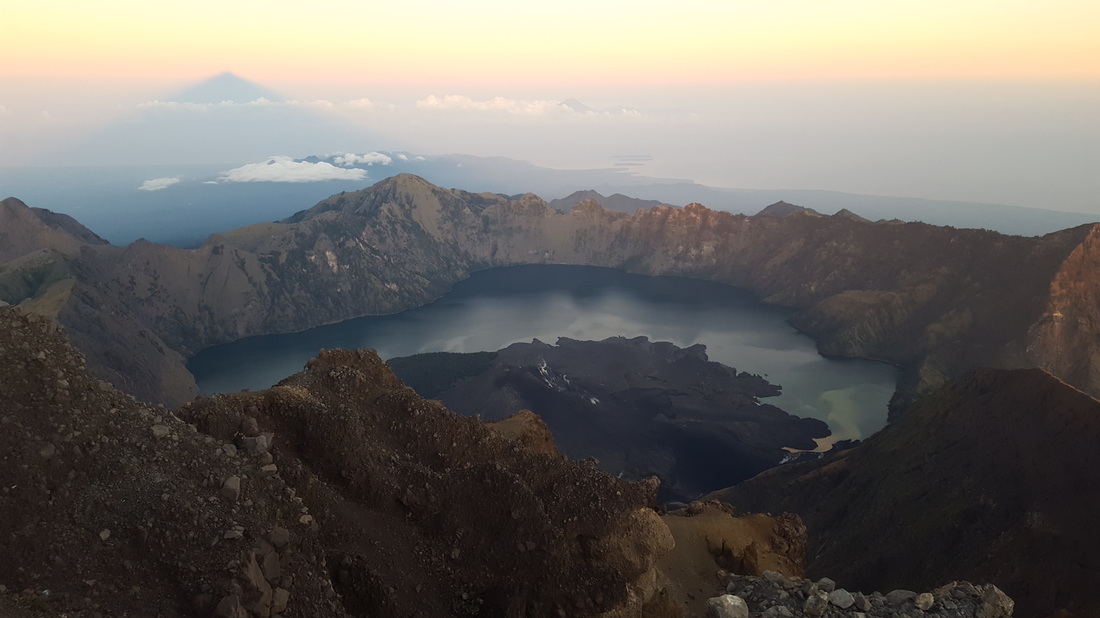|
Indonesia is an archipelago of more than 17,000 islands (wow!) together as a Republic. That being said, ‘exploring’ Indonesia could not be restricted to just seeing its most famous tourist destination, Bali, or checking out just one of its cities. Each main island is segregated into different regions, ethnicities, culture and geology, and so there is always something new to learn whether you’re in Sumatra, Sulawesi, Guinea, or in this case, East Java. Surabaya, located in the North East of Java, is Indonesia’s second largest city. A bustling place with a dense population, it is a great starting point to explore East Java’s great outdoors - the mighty Mount Bromo volcanic cluster and the cool, scenic highlands of Malang/Batu. Juanda International Airport is where one would typical land in, the closest international access point to these areas. From there, you could choose to hire a driver (contacts of which I will share at the end of this article), or take a public bus which would be a much cheaper option (albeit with more restricted access points, I’m afraid), and even trains (which I would say is pretty comfortable). Here are some places and activities I feel you must not miss when visiting Bromo and Malang/Batu, as well as a rough itinerary of how long you should spend on them. Small streets around the villages lead you uphill, through locally-owned farms and warungs (cafes) Take Long Walks Around The Agricultural Villages Around Bromo From Surabaya, it will take around 3 hours to reach the villages around Mount Bromo. Once you're there, you’ll be spellbound by the serene landscapes of the mountains - the fertile volcanic soil means that villagers around would naturally opt to venture into agriculture. Small houses line the narrow roads, the terraces are filled with vegetables growing beautifully, and pine trees dot the hillsides reminiscing somewhere in Europe, almost. In the afternoons and evenings, there really aren’t many things to do in these small villages, but taking a walk around them is such a treat. Pack a jacket and a bottle of water and you’re all set to explore the small lanes and uphill roads that lead to scenic views. There are plenty of small warungs (local cafes) when you need to stop and chill, and make friends with locals. Make sure to pack a jacket for your Bromo adventure - it gets pretty cold especially in the mornings/nights Catch the Sunrise Over Mount Bromo Mount Bromo is technically not just a singular mountain. It is actually part of the Tengger volcanic mountains of the Bromo-Tengger-Semeru National park ('Bromo' comes from the word Brahma, a Hindu God). Though perhaps being more famous due to its photogenic qualities, Mount Bromo is best viewed during sunrise, when the clouds descend and the early sunshine highlights the beautiful contours of the mountains. This will of course require you to get up extremely early in the morning (as early as 2am, as sunrise is around 5am), ride a jeep and head to the sunrise viewpoint. Almost all the hotels in Bromo provide this service, and be sure to get in touch with your accommodation at least a couple days prior to book your spot. After the sunrise, you can also opt to go towards the crater, where you can enjoy stupendous views of volcanic landscapes and beautiful green fields. The entire experience should be over my late morning, as the sun will then menace and it will be too hot to be in the vast, desert-like open space. Tip: Mount Bromo is absolutely freezing especially when it is dark out. Be sure to bring a jacket, and even a hot Thermos so that you can enjoy the beautiful sunrise while sipping a warm beverage. Beautiful organic apple farms with gorgeous hillside settings make for a wonderful morning spent outside Apple Picking In Organic Farms Around Malang/Batu Malang/Batu used to be an entire city, but these days the two are seperated, albeit still next to each other. You can easily reach Malang via bus, train or a rented car. Malang is an old city, dubbed the Paris van Java due to its mild climate. Back then, it was extremely popular with the Dutch during the early days of colonialism. Now Malang is a home to many universities, most of its historical buildings are well preserved and it is well-known for its cafe culture. Batu, on the other hand, is a popular area for agriculture, especially apple farming. Plenty of small, local farms offer the experience of apple-picking, and you can even take them home. In the early mornings with mild pleasant weather and hilly landscapes, spending your time at one of the organic farms browsing through trees and snacking on fresh apples is a pretty great way to spend your time. Coffee, affogato, mild weather, quaint cafes - the makings of a wonderful late afternoon Coffee Tasting In The Many, Many Cafes Around Town Javanese coffee is world-renowned. And so when you’re in the Javanese mountains with plenty of cafes serving single-origin coffee with elaborate care as to how they are grown and harvested, it’s almost a sin to not indulge in them. Most cafes around Malang/Batu have an extensive list of beans to choose from, and paired with wonderful weather, it is an enjoyable experience even for a novice like me. I recommend Java Roasters cafe in Malang (beautiful interior, delicious meals, friendly staff) and De Potrek Cafe in Batu (amazing views, delicious affogato) if you’re wanting recommendations. Be adventurous and try local delicacies in the many, many restaurants around town Sample Delicious East Java’s Local Delicacies If you’re not trying out local cuisines while you’re travelling, did you even travel? Indonesian food is an identity of its own, often recognised for its sambals and spices. In East Java especially, a popular favourite is the pecel, which are blanched vegetables dressed in smooth, mild peanut sauce (they give your usual salad dressing a run for its money). Malang, on the other hand, is also called ‘tempeh town’, and true to its name, tempeh is everywhere. Served in many different ways and variations, it’s definitely an experience to sample them. Other notable local specialties are deep-fried duck (crispy skin!), beef rendang, soto and satay (all of them taste different from the Malaysian versions, so give them a shot!). From intricate hand-made batik to art pieces made by local painters, you'll be spoilt for choice Feast Your Eyes (Or Even Get One For Yourself!) On Local Batik and Art Pieces Art is a beautiful exhibition of local culture, and East Java has plenty of it. Perhaps more notable for its batik, there are plenty of local stores that sell garments and ready-to-wear clothing made with specific Javanese batik prints. Even if you’re not interested in buying one, checking them out gives you an idea of the intricacy that goes into producing these pieces (and even what they actually mean). Art pieces made from local artists are also depict the region’s history and lifestyle. The best part? Most of them are quite affordable to purchase. Most of these shops open all day but close early at night, so it's best to get this done during the day. A gigantic, elaborate showcase of architecture, Tiban Mosque is an interesting place to visit in the afternoons Explore The Alluring Tiban Mosque
Tiban Mosque is located quite a distance away from the main Malang Town, so if you plan to go, be sure to allocate at least half a day for it. Getting a hired car or a rental would be the best option, as it is located away from the main city/town. A beautiful religious complex constructed in the middle of a village, Tiban Mosque gains inspiration from Spanish, Buddhism and Eastern Europe architecture. It also serves as a religious school and the compounds are beautifully curated. A shrine takes centre stage outside the main building, although the interior of the mosque is also stunning. The entire area is beautifully shaded with palm trees and one could not deny the sense of zen this place invokes. Legends had it that this mosque was built by djins in the middle of the night, because no one noticed the building of it during the day. The truth was the government had initially disapproved of the construction, and so villagers resorted to building it at night instead. The mosque provides an interesting offset of luxury from its surrounding, with tiles imported from Europe, chandeliers everywhere, a maze of beautiful rooms for different purposes and magnificent domes. Entrance to the mosque is absolutely free, although donations are absolutely welcomed. Modest dressing is compulsory. NOTE: If you're looking for a driver for your trip in and around Surabaya, you can always contact Dewo ( Phone/Whassap: +6285232157200, Facebook: Ajen Trip Bromo) who brought me around. He was nice and courteous and very helpful! This is obviously not written for the expert hikers nor the Dwayne Johnsons out there. I recently went for a hiking trip to Mount Rinjani, 3726 meters above sea level, and it was not at all easy. It was a lot of fun and I thoroughly enjoyed it, but I’ve also gathered some insider’s tips to make future trips more prepped and hopefully come back next time with all my toenails in good condition. 1. Get Your Shit Together If you’re of average fitness and you think you’ll just ‘wing it’ to the summit, you’re going to have a baaadd time. As we climbed the summit at 2 am in the morning in the freezing cold weather, with the loose volcanic gravel making me slip backwards after every step, boy was I glad I trained for it. At the very least, getting your body trained for long hikes will avoid you crying along the way thus sparing everyone else the agony of having to listen to your endless whining. 2. Wear The Right Shoes Upon realizing that my feet tend to blister rather easily, I decided to opt for my regular gym shoes for more comfort. True up to a point, but anything other than hiking shoes will give minimal grip when you’re climbing slippery slopes or going down unconsolidated pathways. At some point, I had lost count how many times I fell on my butt, and not even in an elegant manner. Not to mention your ankles will really hurt afterwards from the lack of support (for the next two days I walked around like a grandma with a really bad case of arthritis). 3. Make Sure You Have Warm Clothes Part of the hike requires camping around the Sembalun Crater, 2369 meters above sea level. The altitude makes the temperature drop really fast come night time, and you’ll regret not bringing a proper thick jacket and warm pants (trust me, I experienced this first hand). The midnight climb is even colder, and you’re doing yourself a favour if you bring gloves as well. 4. Bring Good Company All I’m saying is, if you’re going for a long hike where you will be sweating, sticky, smelly, not showering, not brushing teeth properly, yucky hair, altitude sickness, burping, farting, exhaustion and the works, hey, you might as well do it with people you like and someone you feel comfortable with. (Reminder: high intensity activities like this is also a great chance to see people’s true colours.) 5. Listen To Your Body In general, you should always do what is within your physical capabilities and not pressure yourself too hard. There will always be people who hike faster than you, and the porters with the heavy camping loads and frail flip flops will hike past you with such ease that it makes you feel bad that you’re panting so much. I knew I was not going to enjoy myself as much if I had to carry all my stuff by myself, so I hired a porter to do it for me. If you’re tired you should just stop for a breather, and take your own time in doing so. This is the part where Miley Cyrus’s “The Climb” really makes sense literally. 6. Be Adventurous In every sense of the word. Try to be more open and up for new things. On our last day our guide invited us for dinner at his house which was a good opportunity to sample real local food and observe the local lifestyle. The meal did not disappoint at all, and it was easily one of the best we had throughout the whole trip. The hike is also a good chance to chat up to strangers and make new acquaintances! 7. Bring Medication As usual as it is with all sorts of travels, sometimes you’re bound to get sick or food poisoning or other physical discomforts. In these instances, it is always good to always have the standard meds ready – aspirin, stomach ache meds etc. 8. Enjoy Yourself Hiking Mount Rinjani will not be an experience you’ll forget anytime soon. The weather is gorgeous, the guides are pleasant and the view is mystical. The vast grasslands remind you of a scene in ‘The Sound of Music’. The fog rolling into the hills makes it look like a magical forest with tall pine trees. The calm water of the crater surrounded by ragged volcanic rocks. The clear night sky so vivid you could see the Milky Way. The sunset and sunrise across the horizon. Eating goreng pisang on a mat watching the sun go down with wonderful company. Try to be present and be completely aware of where you are and who you are with – it’s the best part of the whole trip. So there you go. Some of the tips above are things I did, and the rest are things I wished I did. Nevertheless, it was all sorts of good fun and despite losing a toenail, I was really glad to have climbed the summit of the wondrous, amazing Mount Rinjani!
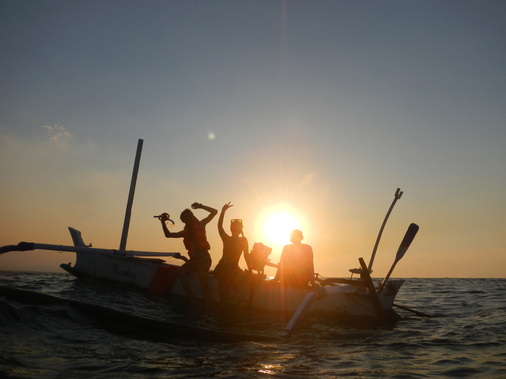 Sunset Snorkeling on the small dodgy wooden boat. 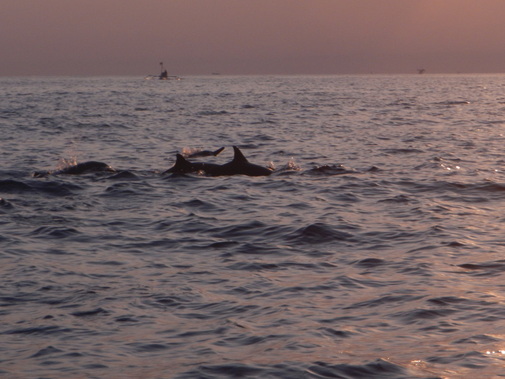 Dolphins! 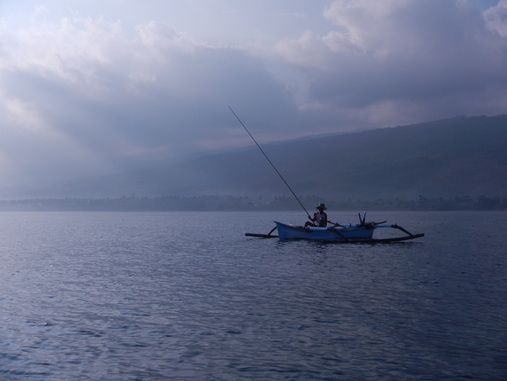 Sunrise around Lovina. Local fisherman.  Pak Madu grilling some fish. 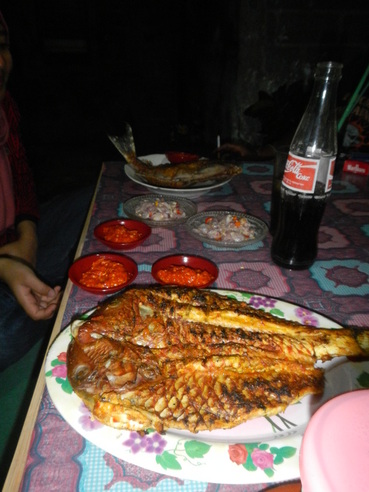 Parrot fish with chili and Balinese onion relish.  The small pool at the resort. Here’s the thing about Bali. It is no doubt an island of its own. It will be like nothing you’ve ever seen anywhere else. It has its own thing going on, its own vibe, its own culture, but only if you know how to find it. Personally I felt that all that was hazed by the growing Westernized culture brought over by foreigners, especially in the Southern part of the island.
We arrived at the Ngurah Rai International airport pretty late, as we spent the whole day discovering Surabaya in the Javanese island. That particular night, we stayed at Tunes hotel (for the love of God, don’t ever do this! There are so many other nice hotels with the same price range around the city), too tired to do much. Now, I would gladly split my travels in Bali into two – the South of Bali, and the North of Bali. The former is a modern, hip, Westernized side of the island, and the latter is the tranquil journey one would hope to get from an island escape. It takes anywhere between two to four hours to get to the Lovina, North of Bali, from the Southern central. It’s great if you’ve got a great Pak Supir (driver), which we luckily did, as the long trip would then be filled with stories on Bali history, hidden hot spots and an extensive introduction to Bali Hinduism. Lovina was so quiet that I couldn’t believe it belonged on the same island as the heavier, noisier cities of South Bali. We stayed at a small resort owned by a German man, with a small empty pool and a narrow beach. At late evening, our Pak Supir introduced us to a local guy named Pak Madu. He was a local fisherman, very well over his forties, but fit as a horse. He owned a small wooden boat and agreed to take us sunset snorkeling (about RM50). Sunset snorkeling was like nothing I’ve ever experienced. I’ve been to many, many snorkeling trips before, but there was something about that particular snorkeling experience that I would always remember. It could be the fact that we travelled to the middle of the sea on a small wooden boat that could only fit four people and looked like it was going to collapse anytime soon. It could also be the fact that the current was so strong that the boat didn’t seem like it was moving. It could very well be the fact that as I went in and out of the water, the orange sun was setting, and the water became eerie and dark, but exciting at the same time. There was absolutely nobody else around for miles, just the three of us and Pak Madu, who sat at the edge of the boat, daydreaming with a cigarette. By the time I was done I was panting, because the current was so strong it was challenge to keep up. Another must-do action item in this part of the island is to go dolphin watching. Pak Madu was nice enough to come knocking at our door as early as 5.30 a.m., to make sure that we wouldn’t miss a thing. On that foggy morning we climbed into that same small wooden boat, and it slowly chugged into the now-calm sea. As we moved peacefully across the water, the sun rose above the fogs and it really was a nice wake-up jolt of excitement. But it gets better! Soon we saw what we were there for. Dolphins! Hundreds and hundreds of them, swimming in schools, in and out of the water, against the rising sun. I couldn’t contain my excitement I think I shrieked so loud Pak Madu was startled. The dolphins were on their regular morning migrates to get some breakfast near the shore. There were other small boats with us too, and as we move with the dolphins, we saw them swimming gracefully near the surface of the water, doing occasional summersaults that received applause from all of us, in the early morning air that was cool and crisp. It was a sight to behold. I hope the Balinese government would do their best to protect the dolphins’ wellbeing. North Bali is the perfect place if you’re looking to stay at a place where tranquility is priority, with a lot of things to see and do. I was glad to be there with good companion, as the nights can be a bit dull, so it’s best to have companion and you can spend endless hours hanging out by the pool doing nothing. Where to Eat: This side of Bali wouldn’t have too many modern eating places, so you’ll have to settle for local shops and there are plenty of grocery stores to get whatever you need. Pak Madu, aside from being a local fisherman, also owns a small eating place. The style was very original – you choose the fish you want (which were personally fished by Pak Madu), and he will prepare them with only one style (grilled), and it’ll be served with condiments, stir fried vegetables and rice. We ate in a small hut while being bitten by mosquitoes, but it was alright. If you’re feeling a bit more adventurous, try the parrot fish. They look to brightly colored to be edible, but they’re pretty delicious.  View of Mount Bromo at sunrise.  At the base of the hills 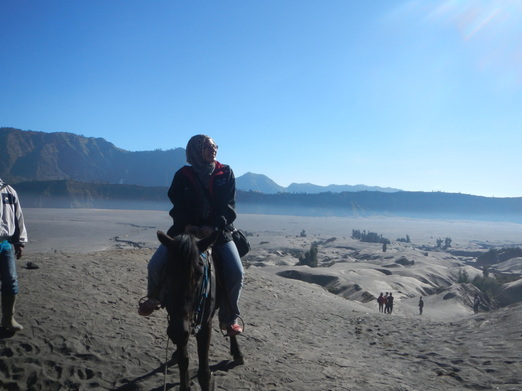 Mariah on her horse. Too tired to walk back to the car? 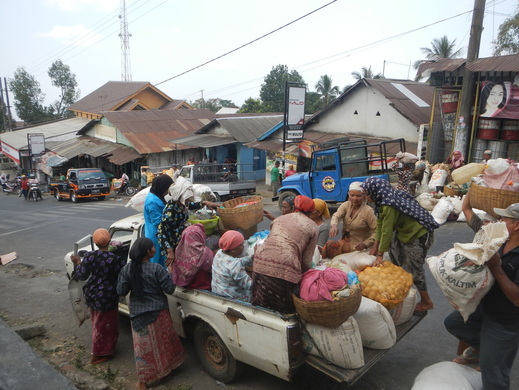 Locals packing up their green products. Based on the dodgy experience getting on 15-hour train in Vietnam, we were prepared for anything, but were surprised by the fact that the train was well maintained and clean. They even had a massaging service throughout the ride at a very reasonable price, for you to kill the hours on the train. The ride itself was quite scenic – you’ll pass endless paddy fields and villages, set around beautiful green hills.
We got to Surabaya quite late, and had to take a drive for about 3 hours to the base of Mount Bromo, a small village called . A little note that when Travelpedia says it’s chilly, for the love of God please believe it. I didn’t take this warning seriously, and was only prepared with a thin pashmina. As I woke up from that long drive, after being awakened occasionally by the dying cough of the van’s engine, I found myself shivering so bad that my teeth were clattering. We were greeted by the homestay’s staff wrapped up in thick jackets, and that when I knew I was screwed. Thankfully they provided jackets for guests, and although their version of stylish was a bit 1980s Beijing, with sparkly furry white parkas, I was glad I was no longer freezing. We had to wake up as early as 3 am to catch the sunrise, and as I woke up groggily, froze my butt on the toilet seat and climbed onto the back of a four-wheel drive, we drove up to the view point of Mount Bromo. We stood there in the dark, shivering and waiting for the sun to rise, and when it finally did, it really was a sight to behold. The initially dark horizon emerged to be a vast horizon of volcanic hills, some with craters that was vivid and spewing with sulphuric smoke. Behind the lonely deserted mountains was a fine long horizon of orange sunrise, emerging and enlightening the panorama. A thin layer of clouds covered the floor of the base of the mountains, and I swear to you it reminded me of one of the places you see in fantasy movies, the volcanoes being a place where the dragons and mystical creatures reside. As the morning got brighter, we drove down to the base of the mountains. It is a large volcanic ash desert, with locals parading around dragging their horses for tourists to use in case they were too tired to walk. You can choose to either walk around and enjoy the scenic volcanic mountain ranges or take the challenge and climb up the mountains to see the crater. We chose the latter, and thus started my climb, wearing skinny jeans and feeling like my hip bone was getting detached. The view on top was worthwhile though. You get to see the crater up close, a large hole that seemed to not end beneath the earth. We drove about to get a better look around, and this is highly recommended as the place was huge, and you’d better explore as much as you can away from the center of tourists and horses. If I were alone, I would take off my shoes and run like a crazy person across the fields, but I was not. The open, beautiful scene was liberating. Although I was nowhere close to ending my travel in this region, I could easily tell that this was going to be one of the highlights of it. More photos here. Where to Eat: There’s not much to choose from, really. The locals seemed to not have many eateries open for outsiders, so we stuck to the food at the homestay, which was not too bad. The village is a center for agriculture, with a vast amount of broccolis, spring onions and oranges being harvested. If you have more time, which we sadly didn’t, you should try venturing out and finding local places to try out these fresh veggies. 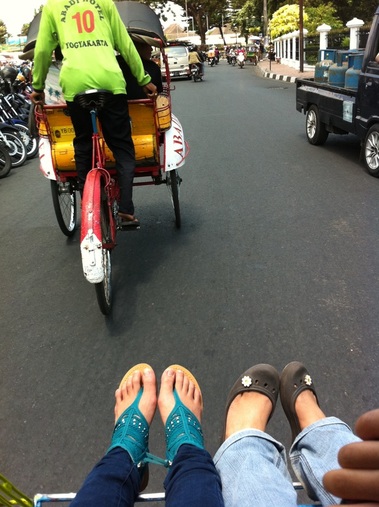 Trishaw ride around town. Easiest and cheapest mode of accomodation 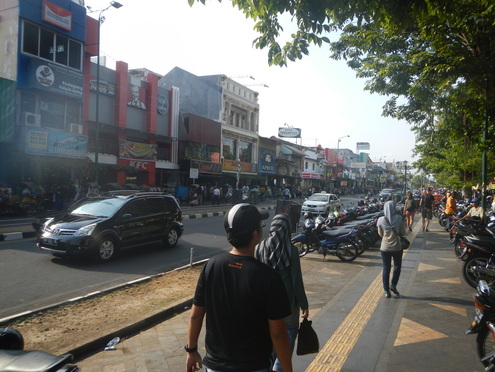 Malboro Street, the main street of Yogyakarta 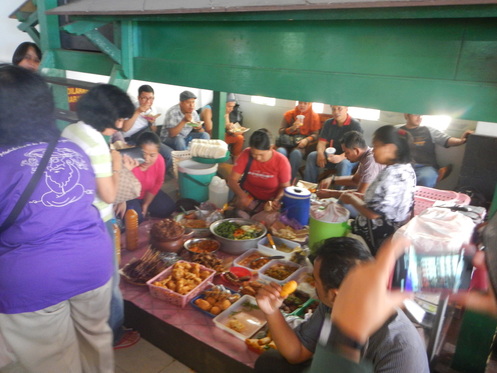 'Lesehan', a famous lunch option around town. 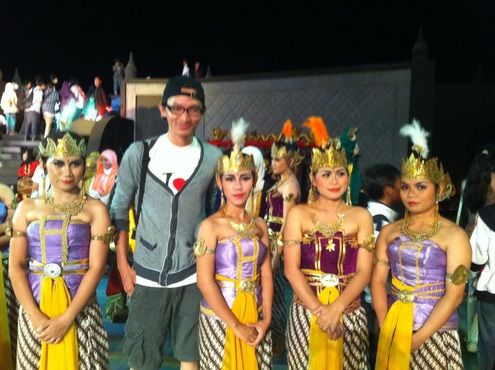 A gleeful friend with the cast of the Ramayana dance after the show In the future, whenever I recall Yogyakarta, I’ll always remember these two things – trishaws and horse carriages. It seemed like Yogyakarta is a bustling town stuck between two time zones, a modern Indonesia with fast food chains and fancy Western cafes, and a traditional Indonesia, with man-fueled transports (the trishaws and horse carriages) hogging the main streets.
Yogyakarta is a city that doesn’t seem to have city-like folks. Everybody seemed so relaxed and going at the own paces, not rushing to get anywhere at all. It was mainly warm and sunny when we visited this city. I highly recommend wearing comfortable footwear and breezy clothes, because God knows how much sweat has the ability to ruin your adventure streak.We walked around the city by food, exploring the shops, cafes and the old Kraton (the old castle square). We took a trip to Prambanan, where the Prambanan temple is located, and on that particular night there was a ballet performance depicting the famous story of Ramayana. It is a good way to get acquainted to the Hinduism belief that is quite prominent in these parts of Indonesia. The main tourism street in the city would be Jalan Malboro (Malboro Street). It’s a stretch of long road, a mixture of cars, trishaws and horse carriages passing by, and along the street you’ll fine people selling all sorts of things – souvenirs, leatherwear, food, cultural items and batik. It’s a good idea to take a nice walk from end to end of the street, and there’s a tourist information office in the middle of the street, with very helpful staff. Yogyakarta is a mellow place, and one should expect to be just that here. You walk by the street, stare at people who are staring at you, hang out at cafes, buy strange items and randomly talk to people by the street. When it gets too hot you should get yourself a bottle of ‘teh botol’, which is basically iced tea in a glass coke-like bottle, and carry on walking around. More photos here. Where to Eat : In Yogyakarta, you might want to try the fried chicken restaurant chain, Ayam Goreng Suharti. Championed by a botox-clad looking Mama Suharti, the friend chicken is both crispy and moist, and you’ll love it.  Route Map. I try to make it a point to go for a backpacking trip at least once a year. It isn’t the same as taking trips to a single place at a time. That would be a called a vacation. A backpacking trip for me requires three things – careful planning, energy and minimal luggage. A vacation is when I go to a certain place to relax, unwind and not think of anything. A backpacking trip, on the other hand, requires a go-go-go attitude. When I come home from a vacation I am usually refreshed, slightly tanned and energetic. When I come home from a backpacking trip I am usually sunburnt, bruised and have had very little sleep.
This time around we decided to explore East Java and Bali. I had been to Jakarta and Bandung earlier this year, and so this wraps up my ‘Visit Indonesia Year’ plan. We wanted to cover as many places possible, while also having enough time to explore them. Here’s the map of our route throughout the trip. 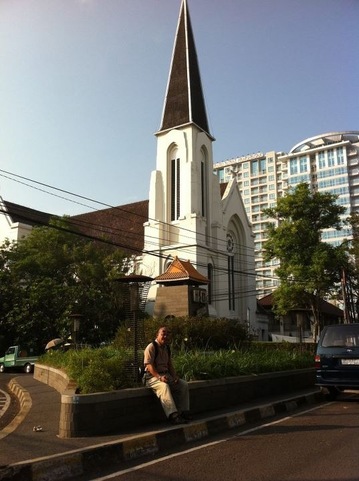 Lots of dutch-influenced buildings around Bandung 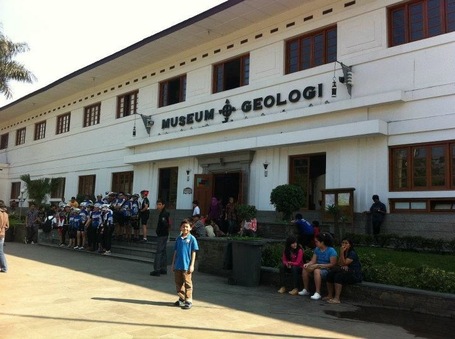 I wouldn't recommend this place, but geeky dinosour-loving kids will love it. Oh wait that's me. 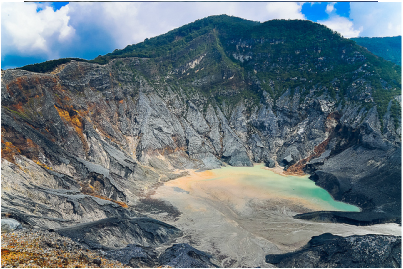 Tangkuban Perahu Crater, about 2 hours from Bandung 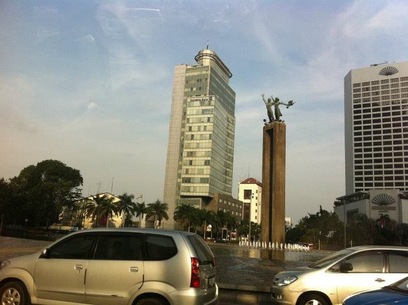 Most of the sceneries of Jakarta like this can be seen from the car. Travelling with your family is not at all like traveling with your friends, not that one is better than the other. With friends, it’s a lot more laid back, but with your family, especially if the age ranges from middle-aged to children, it becomes a production to come up with the plans and itineraries. That being said, nothing is quite like seeing the world with your family. After all, these are the people who’ve seen you at your worst and best, so there is no pretense whatsoever.
I took my family for a trip to Bandung and Jakarta last month. It required a lot of planning, a lot of last minute ticket changes (My sister had an exam! My Dad couldn’t get more off days from work! And all that) and a lot of arguments (as we all do). But finally we all got it together and arrived at Bandara Husein Sasteranegara Airport that very late evening. Bandung quickly reminded me of a Dutch street. Almost all of the houses by the road (and large mansions, if I may add) had Dutch influences in them, most notably the rooftops. The city had a bearable traffic flow, a nice mild weather that got slightly chilly as night approaches, and throngs and throngs of factory outlet stores. Now I am not much of a travel shopper. I don’t like to waste my traveling budget by shopping my way out of a country, but apparently my parents didn’t agree. We spent a whole day browsing lazily through the factory outlets, and tried various different restaurants that served local food. Dining is cheap in Bandung, even if you eat at a proper restaurant as opposed to the hawker stalls by the street. At night we would order room service (much cheaper than the ones in Malaysian hotels!) and watch dodgy HBO movies in bed, with my Dad trying to be as cool as the young ones and stayed up watching movies, but finally snoring off after the first fifteen minutes. A couple of days later we decided to do some sightseeing. We asked our supir (that’s ‘driver’ in Indonesian speak. Hiring one is much cheaper than hailing a cab all day) to take us to Tangkuban Perahu, one of the still active volcanoes near the city. It was a nice two-hour drive, and the place was quite a sight, but holy cow the street vendors are awful! They kept shoving stuff in my face and forcing me to buy stuff, even going as far as getting in the picture frame as we were taking photos. That sort of ruined the mood for that whole visit. The road to and from the crater was quite pleasant, with local houses and shops selling interesting things, as well as nice small boutique hotels. I saw a lot of rabbits being sold by the streets though. I hope they are sold as pets (but to be honest, I don’t really think so). We spent the remaining days of our trip in Jakarta. I wish I could say a lot about the city, but between getting stuck for hours in the traffic, spending our remaining cash in Tanah Abang (another fabric and clothing outlet), there really isn’t much to compliment besides the fact that art seemed to take center stage – there were monuments and statues at almost every roundabout. I’m sure if I had more time, Jakarta would be more appealing, but for me the two days are filled with memories of sitting in the car for hours watching the world pass by. Places to Eat : There is a chain restaurant called ‘Ayam Pop’, if I’m not mistake, which serves Nasi Padang. It’s awesome, cheap and the place looks clean and decent enough. If you’re adventurous then there’s a wide variety of hawker stalls to try. |
Archives
December 2023
Categories
All
https:/
/www.bootsoverbooks.com/
|
